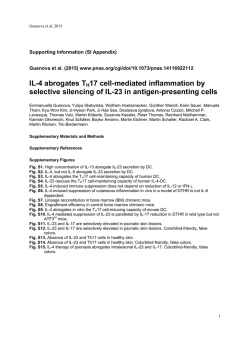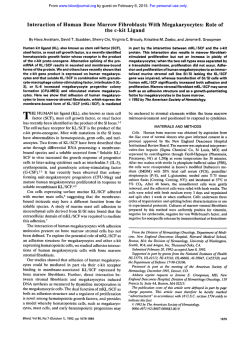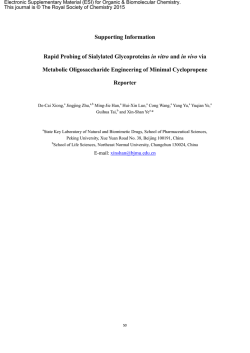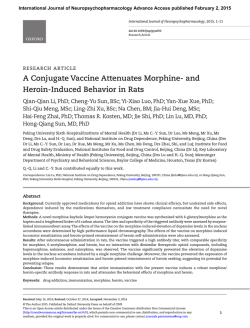
Download Supporting Information (PDF)
Supporting Information Weyemi et al. 10.1073/pnas.1418139112 SI Materials and Methods Cell Culture and Treatments. Human fibroblasts (CTRL: GM03652 or GM00637; A-T: GM02052 or GM05849) were grown at 37 °C with 5% (vol/vol) CO2 in DMEM (Invitrogen) supplemented with 15% (vol/vol) FBS (Atlanta Biologicals). All media were supplemented with 2 mM glutamine, penicillin and streptomycin (Invitrogen). ATM inhibition was performed by treatment of cells with KU-55933 for 5 h (Tocris Biosciences). Fulvene-5 was kindly provided by Jack Arbiser, Department of Dermatology and Atlanta Veterans Administration Medical Center, Emory University, Atlanta. NOX4 dominant negative plasmid (pcDNA3.1-NOX4-DN) was a kind gift of Thomas L. Leto, NIH, Rockville, MD. Transient Transfections. Small RNA interference (siRNA) transfection experiments were performed by reverse transfection with Lipofectamine RNAiMAX (Invitrogen). A SMARTpool consisting of four short sequences of siRNA specific for NOX4 (Dharmacon, Thermo Scientific) along with Scrambled control (nontargeting siRNA) were used under conditions specified by the manufacturer. For the inactive dominant negative form of NOX4 overexpression, cells were transfected with X-tremeGENE 9 DNA Transfection Reagent (Roche) according to the manufacturer’s protocol. Briefly, 1 × 105 cells were seeded in six-well plates 24 h before transfection. The transfection mixture (opti-MEM, X-tremeGENE 9 DNA Transfection Reagent, and plasmid DNA) was incubated at room temperature for 30 min and added dropwise to cell culture wells. Downstream experiments were performed 48 h later as described (1). Real-Time PCR. Total RNA from cells was extracted using TRIzol reagent (Invitrogen) according to the manufacturer’s instructions. Quality of RNA preparation, based on the 28S/18S ribosomal RNAs ratio, was assessed using the RNA 6000 Nano Lab-Onchip (Agilent Technologies). Reverse transcription and real-time PCR were performed as described (2). Oligonucleotides were purchased from Life Technologies and their sequences are available on demand. Alkaline Comet Assay for Analysis of DNA Damage. Cell samples should be handled under dimmed or yellow light to prevent DNA damage from UV light. Briefly, cells were harvested with trypsin, washed once with PBS and resuspended in 1× TE. Cells were then mixed with 37 °C prewarmed/melted 1.6% (wt/vol) low melting agarose (LMA) to make a final agarose concentration of 0.85%. The mixture was spread over sample area on FLARE slides (Trevigen). After lysis, slides were kept in fpg FLARE reaction buffer for 1 h at 37 °C. The slides were transferred in Alkali Solution (pH >13) for 30 min at room temperature in the dark, then electrophoresed (0.7 V/cm/300 mA) for 30 min at 4 °C in the dark. After electrophoresis, the slides were washed three times for a total of 20 min with neutralizing buffer (0.4M Tris·HCl, pH 7.5). Next, the slides were washed in chilled 70% (vol/vol) ethanol for 5 min and air-dried overnight in the dark. The day after, each slide was stained with 40 μL of 1:10,000 diluted of a SyBr green solution (Trevigen). Individual cells with or without comet were visualized using a Nikon fluorescence microscope. Analysis was done by scoring at least 50 comets per sample using the CometScore software package (Tritek). The results are shown as means ± SE. Weyemi et al. www.pnas.org/cgi/content/short/1418139112 Immunofluorescence. Cells were fixed for 20 min with freshly prepared 4% (wt/vol) paraformaldehyde in PBS. After washing with PBS, cells were permeabilized for 10 min in 0.1% SDS. The cells were then blocked with 5% (wt/vol) BSA for 30 min and incubated for 2 h at room temperature with primary antibody: NOX4 (NB110-58849, Novus biologicals), γ-H2A.X (05-636, Millipore), PML (sc-5621 Santa Cruz). After washing in PBS/ 0.1% BSA, cells were stained with an Alexa fluor 488 or Alexa fluor 568 for 1 h at room temperature. Finally, the cells were washed in PBS and coverslips were mounted for analysis. Fluorescent images were captured using a confocal microscope (Nikon PCM2000). Analysis of Cell Senescence. SA β-galactosidase assay kit (Cell Signaling) was used to visualize senescent cells. Primary fibroblasts were cultured in six-well plates and then fixed 3 d after siRNA transfection after being washed twice with PBS. The cells were further incubated for 24 h in the presence of staining solution containing 5-bromo-4-chloro-3-indolyl-β-D-galactopyranoside (X-gal) according to manufacturer’s recommendations (Cell Signaling Technology). Senescent cells were distinguished from viable cells using β-galactosidase, which is blue under the microscope. BrdU Staining. Cells were grown on coverslips, labeled for 24 h in 10 μM bromodeoxyuridine (BrdU) and fixed in cold methanol. DNA was denatured by incubating the cells in 4 M HCl for 20 min at room temperature, and BrdU staining was performed according to manufacturer’s recommendations with FITC‐conjugated anti‐ BrdU (Becton Dickinson). Nuclear DNA was counterstained with 1 μg/mL DAPI. ELISA. Levels of 8-OH deoxyguanosine were analyzed using the HT 8-oxo-dG ELISA kit II (Trevigen) according to the manufacturer’s protocol. Briefly, DNA samples from control and A-T primary fibroblasts were digested with DNase I for 1 h at 37 °C. Samples were then treated with alkaline phosphatase for 1 h at 37 °C and used immediately for 8-OH deoxyguanosine detection. Increasing doses of 8-OHdG (0–200 nM) were used to generate a standard curve. DNA samples (4 μg) were incubated with anti8-OHdG monoclonal antibody at 25 °C for 1 h. Samples were washed four times with PBST and incubated with goat antiMouse IgG-HRP conjugate at 25 °C for 1 h. Samples were then washed four times with PBST and reacted with prewarmed TACS-Sapphire colorimetric substrate in dark for 15 min at 25 °C. The reaction was stopped by adding 50 μL of 0.2M HCL and absorbance was recorded immediately at 450 nm. Intracellular Reactive Oxygen Species Detection. Intracellular ROS levels were measured by flow cytometry in cells loaded with the redox-sensitive dye 2’,7’-dichlorofluorescin diacetate (DCFHDA; Invitrogen Molecular probe). The nonfluorescent DCFHDA readily diffuses into the cells, where it is hydrolyzed to the polar derivative DCFH, which is oxidized in the presence of H2O2 to the highly fluorescent DCF. Approximately 5 × 105 cells were harvested by trypsinization, resuspended in 0.5 mL of culture medium (Ham’s F-12) supplemented with 0.2% (vol/vol) FCS and incubated with 10 mM DCFH-DA for 30 min in the dark at 37 °C. Fluorescence was recorded on FL-1 channel by flow cytometry (BD Biosciences). Western Blots. Cells were washed twice with PBS, directly solubilized in denaturing sample buffer and then subjected to SDS/ PAGE. Proteins were electrotransferred to 0.2 μm Protan BA 83 1 of 7 nitrocellulose sheets (Invitrogen) for immunodetection with primary antibodies: Rabbit monoclonal NOX4 (ab 133303, Abcam), γ-H2A.X (05-636, Millipore), Cleaved Caspase3 (#9664, Cell Signaling). Immune complexes were detected with horseradish peroxidase coupled anti-rabbit/anti-mouse IgG antibody (Amersham). logicals, ab 133303, Abcam). Sections were then washed in Tris·HCl 1× buffer for 5 min and incubated with peroxidaseconjugated goat anti-rabbit antibody. After further washes, peroxidase staining was revealed in diaminobenzidine tetrahydrochloride with 0.1% (wt/vol) of hydrogene peroxide in Tris buffer, 0.01 mol/L (pH 7.2). Sections were counterstained and mounted. Negative controls were obtained by replacing the specific primary antibody by an irrelevant antibody. Kidney was used as positive controls for NOX4 antibody (3). Immunohistochemistry. Seven A-T cerebrum vs. cerebellum tissues with age- and sex-matched controls were obtained from the NICHD Brain and Tissue Bank for Developmental Disorders at the University of Maryland. Immunohistochemical studies were performed on paraffin-embedded tissues. Briefly, 5-μm sections were deparaffinized. Endogenous peroxidase activity was quenched by incubation in 0.03% hydrogen peroxide in 0.1mol/l Tris·HCl buffer (pH 7.6) for 5 min. Microwave/pressure cooker pretreatment was performed in 1 mmol/l EDTA buffer (pH 8). Sections were subsequently incubated for 60 min at room temperature with NOX4 Antibodies (NB110-58849, Novus bio- Statistical Analysis. Statistical analyses of human tissues specimens were performed using the non‐parametric Mann–Whitney t test, and asterisks represents statistical significance (P < 0.05). For ROS detection, BrdU incorporation, immunoblot, senescence and proliferation quantification, comet assay, and 8-OH deoxyguanosine levels, statistical analyses were performed using the nonparametric T test, and *** represents statistical significance (P < 0.0001). 1. Boudreau HE, Emerson SU, Korzeniowska A, Jendrysik MA, Leto TL (2009) Hepatitis C virus (HCV) proteins induce NADPH oxidase 4 expression in a transforming growth factor beta-dependent manner: A new contributor to HCV-induced oxidative stress. J Virol 83(24):12934–12946. 2. Weyemi U, et al. (2010) Intracellular expression of reactive oxygen species-generating NADPH oxidase NOX4 in normal and cancer thyroid tissues. Endocr Relat Cancer 17(1):27–37. 3. Shiose A, et al. (2001) A novel superoxide-producing NAD(P)H oxidase in kidney. J Biol Chem 276(2):1417–1423. Weyemi et al. www.pnas.org/cgi/content/short/1418139112 2 of 7 Fig. S1. Validation of NOX4 antibody. Detection of NOX4 band at 65 kDa. A specific peptide (the amino acid sequence is considered to be commercially sensitive) was used for competition assay to confirm the specificity of NOX4 antibody in human primary fibroblasts from A-T patient (A) and in mouse kidney (B). (C) Detection of NOX4 by immunofluorescence on human A-T fibroblasts (GM05849) transfected with control siRNA or with NOX4 siRNA for 3 d. (D and E) NOX4 detection by immunofluorescence (D) and immunohistochemistry (E) in mouse kidney. Stronger expression of NOX4 was found in the cortex, whereas the medulla and the G. capsules exhibited weaker expression pattern. Weyemi et al. www.pnas.org/cgi/content/short/1418139112 3 of 7 Fig. S2. NOX4 silencing reduces ROS levels in human A-T cells. (A) Control cells (CTRL) as well as A-T primary fibroblasts (A-T) were transfected with siRNA control or against NOX4 and incubated for 3 d before labeling with dihydroethidium (DHE) (Left, representative image; Right, quantification). (B) The deletion of FAD and NADPH binding domain of NOX4 results in a truncated inactive enzyme (NOX4 DN) that exhibits dominant negative effects, and leads to a decrease in endogenous NOX4-derived ROS levels. (C) Representative image of human fibroblasts transfected with an empty vector (pcDNA3.1) or with NOX4 DN (commonly known as NOX4-ΔCt). NOX4 antibody raised against the internal region of the protein (between residues 100–200, Novus Biologicals) was used for immunofluorescence. (D) A-T cells (A-T) exhibited elevated ROS levels compared with control cells (CTRL), levels which were reduced when cells were transfected with NOX4 DN. pcDNA3.1 was used as control vector (Left, raw DCF fluorescence; Right, quantification of the fluorescence mean). *P value < 0.05; **P value < 0.001; #, nonsignificant. Weyemi et al. www.pnas.org/cgi/content/short/1418139112 4 of 7 Fig. S3. NOX4 inactivation results in reduced levels of DNA damage in A-T primary fibroblasts. (A) NOX4 silencing by siRNA resulted in reduced 8-OH deoxyguanosine levels in DNA samples measured by ELISA as described in Materials and Methods. For positive control replicates, DNA from control cells were treated with CrCl3 plus H2O2. (B) NOX4 silencing by siRNA tended to reduce the amounts of phosphorylated H2AX (γ-H2A.X) used as a marker for DNA doublestrand breaks in A-T primary fibroblasts. (Left, representative image; Right, quantification; Fpc, Foci per cell). *P value < 0.05; #, nonsignificant. Weyemi et al. www.pnas.org/cgi/content/short/1418139112 5 of 7 Fig. S4. NOX4 inactivation rescues A-T primary fibroblasts from proliferative defects and senescence. (A) Photomicrograph of cell density. A-T primary fibroblasts (A-T) and control cells (CTRL) were transfected with siRNA against NOX4. Images were taken at day 1 and day 5 posttransfection. (B) Measurement of the nuclear area occupied by the PML bodies is illustrated in control cells (CTRL) as well as in A-T primary fibroblasts cells (A-T) 4 d posttransfection with siRNAs. AU, arbitrary units. Weyemi et al. www.pnas.org/cgi/content/short/1418139112 6 of 7 Fig. S5. Selective up-regulation of NOX4 in the cerebellum of A-T patients. (A) Immunoblot of NOX2 in human cerebellum. Age- and sex-matched specimen of control (CTRL) and A-T tissues (A-T) are paired. HL-60 cells were used as a positive control (CTRL+) for NOX2 expression. (Left, quantification; Right, representative images). (B) Immunohistostaining of NOX4, cleaved caspase 3 and γ-H2A.X in a pair of cerebella. (C) Immunohistostaining of NOX4 in the cerebrum tissues from the same specimens as for the cerebellum shown in Fig. 4. Weyemi et al. www.pnas.org/cgi/content/short/1418139112 7 of 7
© Copyright 2026



